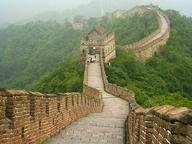Quiz Answer Key and Fun Facts
1. The Yellow River, or Huang He, has a very descriptive name: for much of its great length, its waters really do run yellow. What gives the river its distinctive color?
2. The Yellow River has been called the cradle of Chinese civilization, in honor of the farms and cities that have grown prosperous on its banks. These farms and cities, though, are vulnerable to flooding. Which of these best describes the river's behavior during the 20th century?
3. A great river shapes its landscape not only geographically, but also etymologically. The Yellow River is no exception. Two of its neighboring provinces owe their names to it: "North of the River" and "South of the River." Which are they?
4. If you follow the Yellow River all the way to its mouth, you'll find yourself in the Gulf of Bohai, an offshoot of the appropriately named Yellow Sea. Where in China is this gulf?
5. In the northeastern corner of China, the Yalu River flows southwest to the sea. Its path forms much of the border between China and what other nation?
6. The Yalu flows from Heaven Lake, in the crater of a volcano named either Changbai Mountain or Baekdu Mountain -- depending on whom you ask. Both names, though, mean essentially the same thing. To what aspect of the mountain's appearance do its names refer?
7. While we're on the subject of sources, let's move to China's longest river: the great Yangtze. Flowing from west to east for over 6,400 km (nearly 5,000 miles), in what region does the river originate?
8. Some of the Yangtze's many tributaries flow directly into the great river; others flow into lakes, which then feed the Yangtze. One such tributary lake is China's largest body of fresh water. What is the name of this lake, which was the site of a major naval battle in 1363?
9. The Yangtze River, also called the Ch�ng Jiāng, divides North China from South China. It drains about twenty percent of China's land area, a region housing about thirty percent of the population. Which of the following major cities is NOT on the banks of the Yangtze?
10. On its long journey through China, the Yangtze passes through many areas justly famous for their beauty. Perhaps the best-known is a region that received wide news coverage in the 2000s, during the construction of a controversial dam. What is the name given this 200-kilometer (120-mile) stretch of river?
Source: Author
CellarDoor
This quiz was reviewed by FunTrivia editor
ozzz2002 before going online.
Any errors found in FunTrivia content are routinely corrected through our feedback system.

